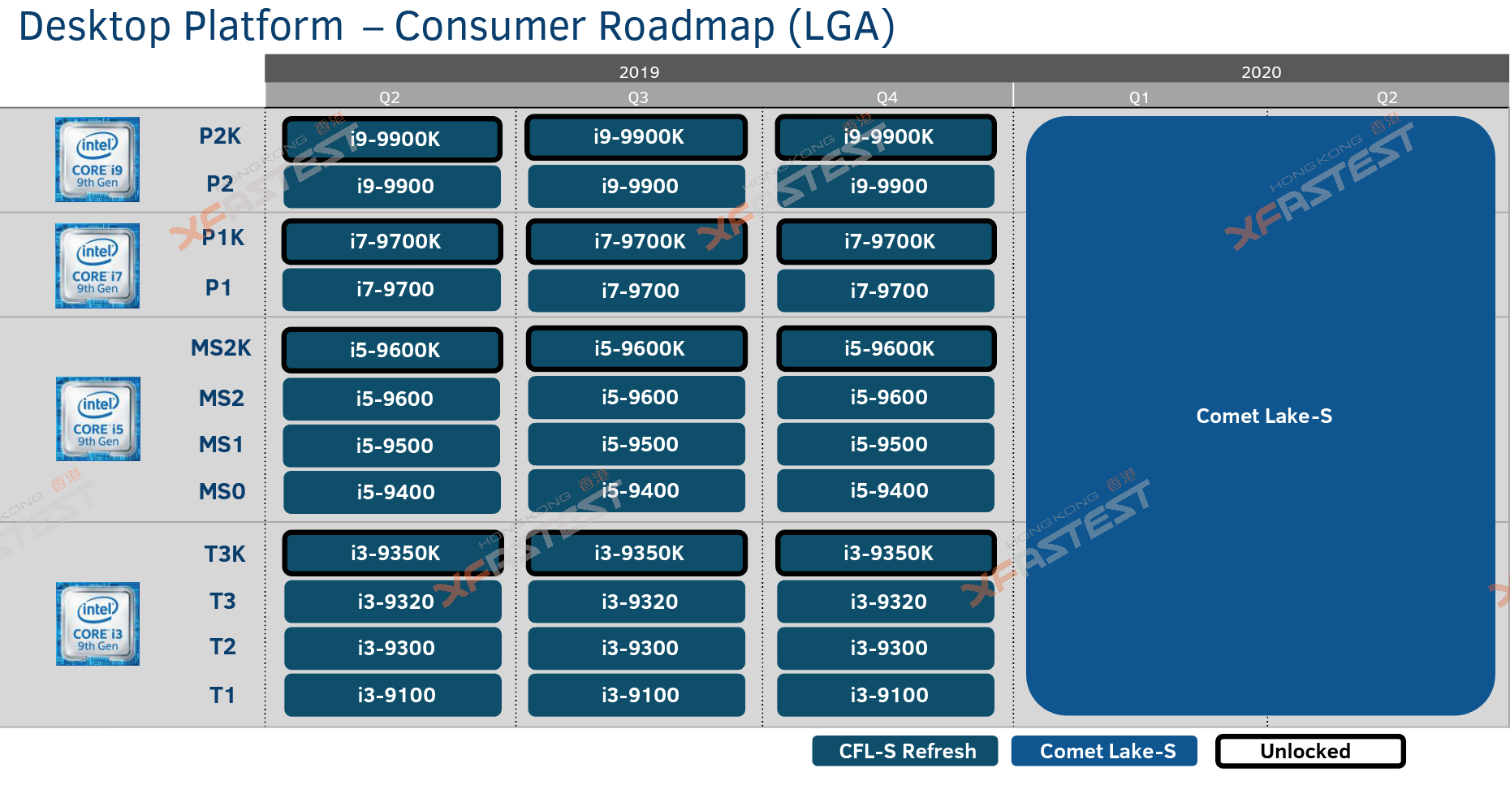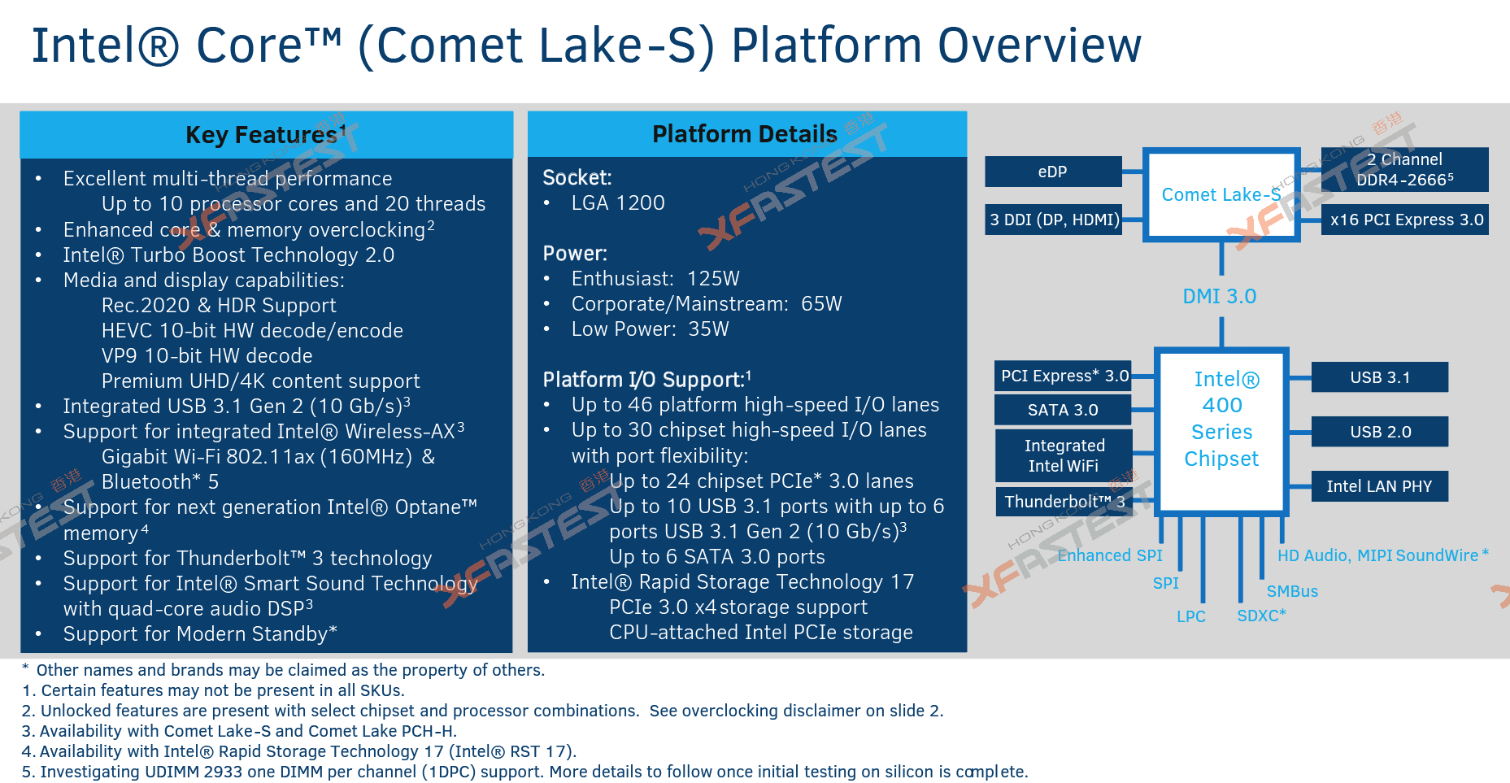Rumor Outlines Intel Comet Lake Features, Specifications, and Launch Window
Rumored details of Intel's upcoming Comet Lake architecture have been posted via XFastest which published supposedly internal presentation slides that mention Comet Lake. The information gleaned from these slides seem to confirm most of the details assumed about Comet Lake thus far: fabricated on a further enhanced 14nm process, up to 10 cores, new chipset and socket, and availability late this year or early 2020. But as with all unverified information, we need to view this with suspicion.
XFastest leaked three slides, one detailing features and specifications of the CPU and new 400-series chipset, one showing the consumer roadmap for the next few quarters, and one revealing the launch window of the processors. There aren't any SKUs or product names on these slides, however.
When it comes to features, the information claims Intel is expanding its mainstream core count from 8 to 10 cores and keeping Hyper-Threading. The slide boasts several new features, such as "enhanced core and memory overclocking," integrated USB 3.1, support for gigabit WiFi and Bluetooth 5, and support for Intel's Optane memory which is currently more of an enterprise technology. The purported new 400-series chipset actually looks quite compelling: it has up to 24 PCIe 3.0 lanes (meaning up to 40 for the entire platform) and up to 16 USB 3.1 ports. It isn't PCIe 4.0 like the X570 platform, however, and it does use a new socket, LGA 1200.
The supposed consumer roadmap is a little less interesting. It basically shows Comet Lake replacing the entirety of the 9th-gen CPUs (based on Coffee Lake) in Q1 of 2020. It does tell us that Comet Lake is a full product stack replacement for Coffee Lake and won't exist alongside it, but otherwise, there's not much here other than the launch window. Curiously, the Core i9-9900KS is missing, even though we know that it is coming later this year.
The final slide shows us more launch windows and availability for mainstream and HEDT CPUs. The Xeon W-3175X doesn't seem to be getting a replacement before Q2 of 2020, and like the previous slide, we see Comet Lake being available in Q1 of 2020. A new X299 refresh, Glacier Falls, is apparently arriving in Q4 of this year, and it will be based on Cascade Lake. We've heard about Glacier Falls before, but it has not yet been seen; if this refresh comes up late this year, then we may be able to expect these slides to predict the launch of Comet Lake as well accurately.
If these slides are accurate, then Intel is not planning a response to Ryzen 3000 until early 2020 at best, which is a shame since we would like to see a more competitive series of Intel CPUs sooner rather than later. But, as with all leaks, take this with a grain of salt.
Get Tom's Hardware's best news and in-depth reviews, straight to your inbox.

Matthew Connatser is a freelancing writer for Tom's Hardware US. He writes articles about CPUs, GPUs, SSDs, and computers in general.
-
salgado18 Oh, look! What's that? The second leak about the next Intel CPUs, four days after Zen 2 lauches? What a coincidence! </sarcasm>Reply
Intel is in damage-control mode, until a new architecture and/or 10nm is ready. But it doesn't help that a new socket is needed. Top end will keep dominated by Ryzen 9 3950X, but they will battle hard from 10/12 cores down, which could be interesting. -
Armani316 So for the next H-Series Mobile CPUs for high-end laptops, should we expect 14nm Comet Lake or the 10nm Ice Lake during H1 2020?Reply -
ingtar33 ReplyArmani316 said:So for the next H-Series Mobile CPUs for high-end laptops, should we expect 14nm Comet Lake or the 10nm Ice Lake during H1 2020?
intel isn't able to get high clock speeds out of their 10nm process. thus far the only planned 10nm release is for their atom/low end mobile chip lineup, and apparently (per some insider leaks) while there is a 15% ipc improvement over current atom processors, there is almost a 20% max clock speed hit, netting a nearly -5% total performance from their 10mn node.
The rumor is Intel is already planning to skip 10nm all together because it just doesn't work right for them, on the desktop/server market. -
Armani316 Replyingtar33 said:intel isn't able to get high clock speeds out of their 10nm process. thus far the only planned 10nm release is for their atom/low end mobile chip lineup, and apparently (per some insider leaks) while there is a 15% ipc improvement over current atom processors, there is almost a 20% max clock speed hit, netting a nearly -5% total performance from their 10mn node.
The rumor is Intel is already planning to skip 10nm all together because it just doesn't work right for them, on the desktop/server market.
Oh wow, really? So for the high-end laptop market (i.e. the i7 & i9 H-Series CPUs), what's the rumor? Are they introducing Comet Lake (14nm) in 2020 followed by Rocket Lake (14nm) in 2021, and then straight to Meteor Lake (7nm) in 2022? So no 10nm Ice Lake, 10nm Tiger Lake & 10nm Alder Lake CPUs for the H-Series? That would shock me to be honest. -
ingtar33 yeah, thus far even intel's roadmaps don't seem to indicate any impending 10nm release on HEDT, DT, or HELT. They made a huge hullabaloo about their 10nm process netting them a 15% IPC uplift and hid in their release that it was for their atom/low power mobile chips only. Considering the rumor for YEARS has been Intel can't seem to clock up their 10nm process which is why it's been delayed for so long, this seems like confirmation of that.Reply -
Armani316 Reply
It makes sense now why Intel talked about their 7nm products a couple of months ago!ingtar33 said:yeah, thus far even intel's roadmaps don't seem to indicate any impending 10nm release on HEDT, DT, or HELT. They made a huge hullabaloo about their 10nm process netting them a 15% IPC uplift and hid in their release that it was for their atom/low power mobile chips only. Considering the rumor for YEARS has been Intel can't seem to clock up their 10nm process which is why it's been delayed for so long, this seems like confirmation of that.
https://www.anandtech.com/show/14312/intel-process-technology-roadmap-refined-nodes-specialized-technologies
I thought the priority for the 7nm architecture is for their upcoming Xe GPUs, but if what you're saying is true, if Intel does not plan on releasing any 10nm H-Series CPUs, we could see the 7nm H-Series Meteor Lake CPUs in H1 2022 if they release the following:
14nm Comet Lake H-Series CPUs (H1 2020)
14nm Rocket Lake H-Series CPUs (H1 2021)
7nm Meteor Lake H-Series CPUs (H1 2022)
This is assuming what you said, that Intel will completely skip the 10nm architecture (2020 Ice Lake | 2021 Tiger Lake | 2022 Alder Lake) for the H-Series CPUs.
Is this what you think is going to happen? I was planning on upgrading my laptop in a couple of years once Tiger Lake H-Series CPUs are out, but now it looks like I'll be waiting another year for Meteor Lake. No way I'm getting yet another 14nm CPU. -
TJ Hooker Reply
That article is talking about a totally different slide than the one features in this TH article. I would say something about reading the article before posting, but in this case all you would have had to do is look at the pictures.dave.jeffers said:Fake.
https://adoredtv.com/fake-intel-10th-gen-slide-circulates/ -
bit_user Reply
I think it was the architecture changes that delivered the IPC uplift, but the process node that's holding back the clockspeeds.ingtar33 said:yeah, thus far even intel's roadmaps don't seem to indicate any impending 10nm release on HEDT, DT, or HELT. They made a huge hullabaloo about their 10nm process netting them a 15% IPC uplift
Unfortunately, the two are sort of intertwined. That's why 14 nm has continued seeing Skylake-offshoots.


